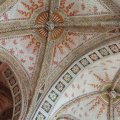CENACOLO VINCIANO
The most famous representation of Christ's last meal surprises the viewer with its beauty and emotional power.
In the refectory of the convent attached to the Basilica of Santa Maria delle Grazie, here is the most famous fresco in the history of art. Painted between 1495 and 1498, at the request of Ludovico il Moro, the Last Supper by Leonardo da Vinci still amazes. Measuring 9 m x 5 m, the subject, as learned as it is dramatic, evokes the institution of the Eucharist, at the very moment when Jesus, his lips still half-open, has just announced to the apostles the betrayal of one of them. Stunned, the apostles, grouped in threes, show their dismay by the strong expression on their faces. Dozens of different interpretations have seen in the composition a musical score, a coded message or extracts from the apocryphal gospels. Damaged by pollution as well as by a bomb which, in 1943, destroyed the refectory while miraculously leaving the wall of the Last Supper intact, but above all by the technique used by Leonardo himself, the colours of the fresco have not stood the test of time. A great inventor, Leonardo did not paint it a fresco (fresh) but used a mixture of oil pigments on a dry wall, so that he could modify the work as he pleased. Twenty years later, moisture and dirt had already spoiled the masterpiece. After several restorations, the Last Supper now seems to have been restored to its former glory. On the opposite wall, a Crucifixion by the painter Montorfano (1495) goes almost unnoticed compared to the brilliance of the Last Supper.
Did you know? This review was written by our professional authors.
Book the Best Activities with Get Your Guide
Members' reviews on CENACOLO VINCIANO
The ratings and reviews below reflect the subjective opinions of members and not the opinion of The Little Witty.
Find unique Stay Offers with our Partners





Le aperture per le visite sono sul sito, i posti vanno a ruba quindi bisogna prenotare con molto anticipo